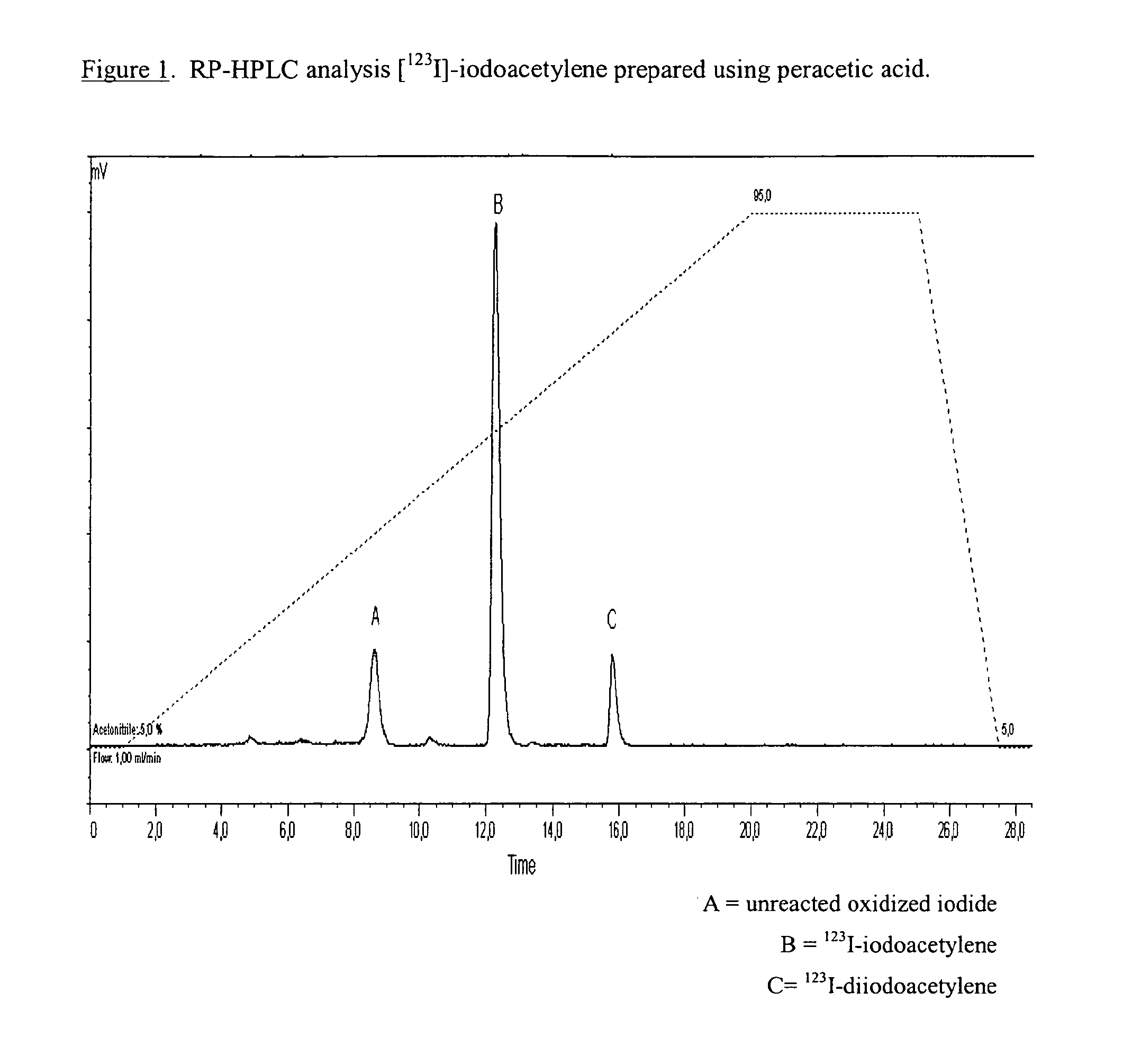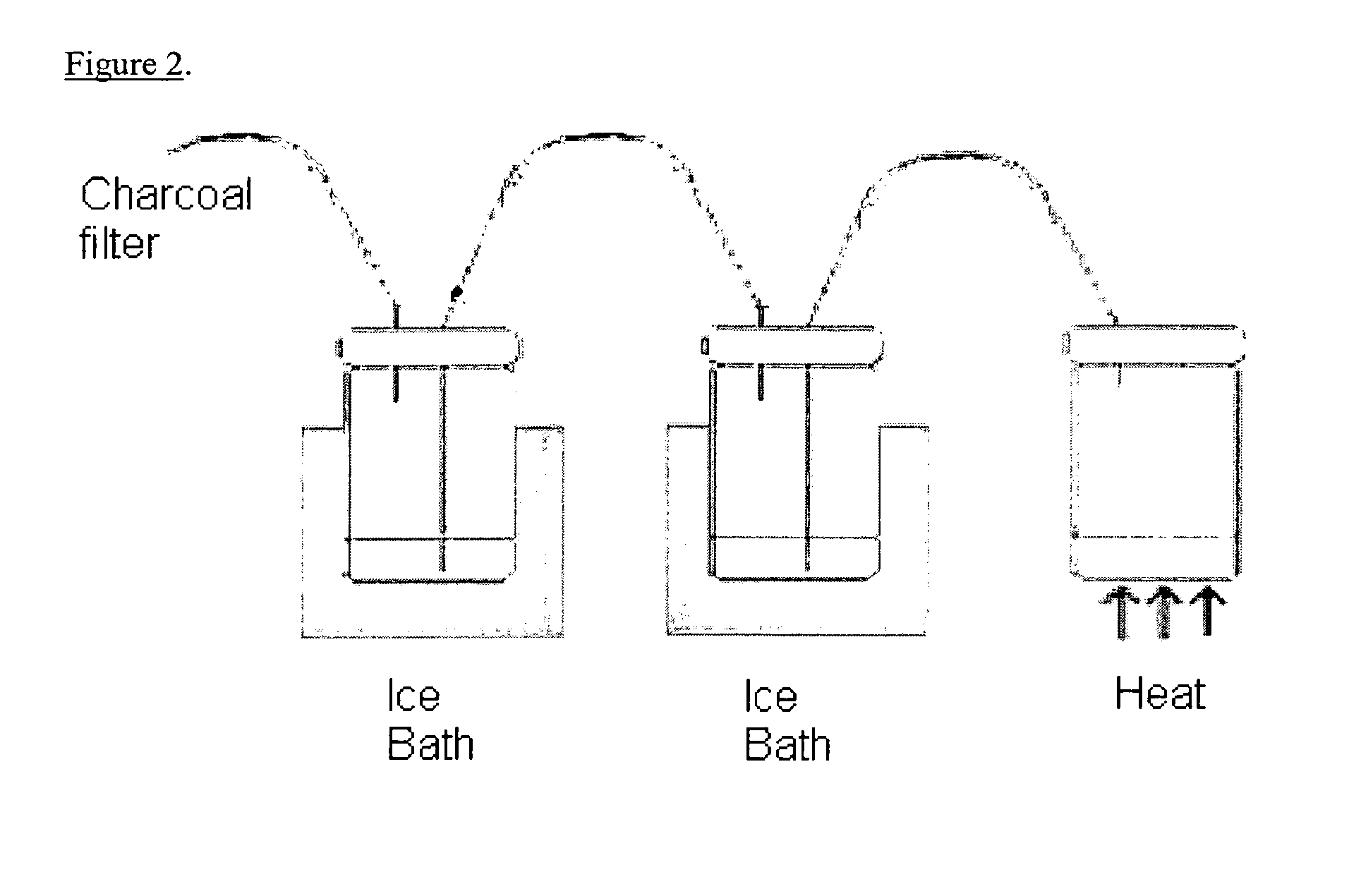Radioiodination method
a radioiodination method and radioiodination technology, applied in the field of radioiodination method, can solve the problems of explosive instability, no specific teaching on how to apply the method to the radioiodination of biological molecules, and no attractive intermediate for fluoroacetylen
- Summary
- Abstract
- Description
- Claims
- Application Information
AI Technical Summary
Problems solved by technology
Method used
Image
Examples
example 1
Synthesis of Iodo Acetylene
[0137]
[0138]Tributyl(ethynyl)stannane (Sigma-Aldrich; 400 mg, 1.27 mmol) in deuterochloroform (2 ml) at 0° C. was treated with iodine (322 mg, 1.27 mmol). The reaction was then allowed to warm to room temperature over a period of 15 min when the colour of the iodine rapidly faded. The reaction was then distilled, and the volatile iodoacetylene in deuterochloroform collected as a colourless liquid. NMR in chloroform indicated that it was a pure solution of iodoacetylene. Yield cannot easily be estimated on this scale, as iodoacetylene is a volatile material.
[0139]1H NMR (300 MHz, CDCl3): δH 2.17 (1H, s, CH). 13C NMR (75 MHz, CDCl3): δC 83.3,(other carbon not visible).
example 2
Synthesis of 1-benzyl-4-iodo-1H-1,2,3-triazole
[0140]
[0141]A solution of iodoacetylene (193 mg, 1.27 mmol, assuming 100% yield from previous reaction) in deuterochloroform (2 ml) and THF (2 ml) at 20° C. was treated with azidomethyl benzene (benzyl azide; 169 mg, 1.27 mmol) [commercially available from Alfa Aeser; Fr. Moulin, Helvet. Chim. Acta, 35, 167-80 (1952)], copper iodide (90 mg, 0.47 mmol), and triethylamine (256 mg, 2.54 mmol). The reaction was then stirred at room temperature over a period of 48 h. The reaction was then filtered through celite to remove copper (I) oxide and then chromatographed on silica in a gradient of 15-50% ethyl acetate in petrol. Two fractions were collected. Fraction 1 was evaporated to give a colourless oil (102 mg, 0.77 mmol).
[0142]1H NMR and 13C NMR indicated that this was mainly unreacted azidomethyl benzene.
[0143]Fraction 2 was evaporated to give 1-benzyl-4-iodo-1H-1,2,3-triazole as a colourless liquid that crystallized on standing (104 mg, 0.36...
example 3
Preparation and Distillation of [123I]-Iodoacetylene Using Peracetic Acid Oxidant
[0145]
[0146]To a Wheaton vial on ice was added, ammonium acetate buffer (100 μl, 0.2M, pH 4), sodium [127I] iodide (10 μl, 10 mM solution in 0.01M sodium hydroxide, 1×10−7 moles), sodium [123I] iodide (10 μl, 20-85 MBq), peracetic acid, (10μl, 10 mM solution, 1×10−7 moles) and a solution of ethynyltributylstannane in THF (Sigma-Aldrich; 100 μl, 0.38 mg / ml, 1.2×10−7 moles). Finally, 400-600 μl THF was added, the Wheaton vial sealed and the reaction mixture allowed to warm to room temperature prior to reverse phase HPLC analysis.
[0147]HPLC analysis at ca. 10 minutes post addition of ethynyltributylstannane yielded [123I]-iodoacetylene with a radiochemical purity (RCP) of 75%. See FIG. 1. The impurity with the longer retention time is believed to be 123I-diidoacetylene.
[0148]The reaction mixture was heated at 80-100° C. for 15-20 minutes during which time, the [123I]-iodoacetylene and THF were distilled th...
PUM
| Property | Measurement | Unit |
|---|---|---|
| particle size | aaaaa | aaaaa |
| molecular weight | aaaaa | aaaaa |
| molecular weight | aaaaa | aaaaa |
Abstract
Description
Claims
Application Information
 Login to view more
Login to view more - R&D Engineer
- R&D Manager
- IP Professional
- Industry Leading Data Capabilities
- Powerful AI technology
- Patent DNA Extraction
Browse by: Latest US Patents, China's latest patents, Technical Efficacy Thesaurus, Application Domain, Technology Topic.
© 2024 PatSnap. All rights reserved.Legal|Privacy policy|Modern Slavery Act Transparency Statement|Sitemap



